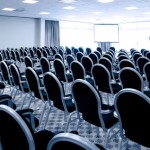 It’s that time of year–the arrival of the annual spring/summer lineup of conferences hosted by the national service organizations in the arts and culture sector. Many will soon be filing into Ballroom D at the end of the Hutchinson Concourse on the Mezzanine Level of some Conference Center/Hotel to hear leading field practitioners share their insights on Innovation in the Arts Sector. Those not in Ballroom D will be hiding out in the bar socializing, having informal discussions, and networking (also known as ‘having a good conference’).
It’s that time of year–the arrival of the annual spring/summer lineup of conferences hosted by the national service organizations in the arts and culture sector. Many will soon be filing into Ballroom D at the end of the Hutchinson Concourse on the Mezzanine Level of some Conference Center/Hotel to hear leading field practitioners share their insights on Innovation in the Arts Sector. Those not in Ballroom D will be hiding out in the bar socializing, having informal discussions, and networking (also known as ‘having a good conference’).
I’ve been attending the annual conferences of national, regional and local arts service organizations in the US for nearly 20 years. I think we’re overdue to turn the arts conference format on its head. In 2010 I was sitting on a dais speaking on a panel at an arts conference and the following thought popped into my head (right before I gave my two-cents on, as I recall, ‘technology and the arts’):
Any one of those sitting in the chairs facing this dais could be up here speaking on this topic. Why are four of us on the dais and the rest sitting in chairs facing us? Instead, we need a room with some coffee or beer and a bunch of couches and chairs and the opportunity for a long chat.
Increasingly, it seems that we’re all absorbing the same tweets, blogs,YouTube videos, TED talks, audio interviews, articles, and reports, and that anything that is truly interesting hits the Internet and spreads to the field quickly. We come to these annual conferences primed and ready to discuss.
There are, of course, alternatives to what has come to be the ‘traditional’ conference format–for instance, Open Space Technology meetings and unconferences in which the agenda or topics for discussion are not determined by the organizers but are determined by the participants. Arena Stage uses a closed fishbowl format (a circle of discussants surrounded by a circle of listeners, with people moving in and out of the inner circle over the course of a few days). At the Scarcity to Abundance convening that I attended in January I noticed that this format had the effect of flattening hierarchies among participants, democratizing the conversation, and enabling everyone that spoke to be ‘heard’.
The TED format seems to be the major innovation in meeting formats of the past decade. I’m a fan of the talks and watch them online all the time but I’ve never been to a TED conference. I suspect, however, that it’s not the right format for the national arts service organization conferences. Unless we invited people who are not working in the arts to speak to us, it seems that there would be a lot of repetition in the talks. TED conferences are interesting because of the intentional diversity of them–the variety of fields, cultures, subjects, points of view, styles, and modes of thinking represented by the speakers. We all use the same jargon at arts conferences and all have (virtually) the same story to tell.
Many sessions at these annual arts conferences currently feature practitioners or consultants or others presenting findings from research or outcomes from new (often described as ‘innovative’) practices they have tried. But now such dissemination of data and experiences could happen just as easily via a Webinar. The NEA released three new reports via Webinar a few weeks back and it was highly effective, as well as time- and energy-efficient.
It seems that technology has made redundant much of the purpose of the annual arts conference and that the yearly gathering of the field (if there is still a reason to have one) needs to be transformed. I’m not suggesting there is not a reason for everyone to get on a plane and fly across the country to hang out; but I am suggesting that the purpose (and thus the structure of the event) might need to be radically different from the corporate-style, top-down, sit-and-learn-from-the-leaders-in-your-field conferences to which we’ve all become indoctrinated.
People sometimes wander the halls of these conferences sighing and saying, “It’s the same conversation we’ve been having for 5, 10, 15, 20 years.” I’ve long thought that this was because the same people have been sitting in the room year after year ‘leading’ the conversation. But perhaps it’s also something about the structure of these events? If form dictates content, perhaps if we blew up the traditional conference format and got some new people in the room talking to each other we would succeed in moving the field conversation forward, as well?
Interior of Modern Conference image by ariadna de raadt licensed from Shutterstock.com.
